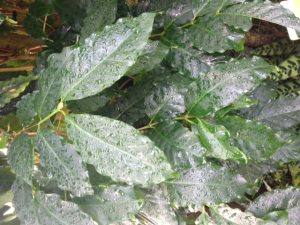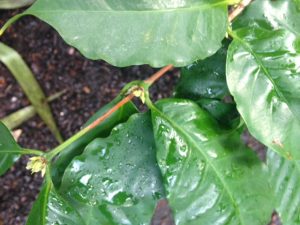 This week bags of coffee beans have been arriving by post in preparation for the Coffee with a Shot of Science event on 4 April, part of this year’s Edinburgh International Science Festival programme. The first beans to arrive were ‘Ethiopian wild coffee’ collected from indigenous coffee bushes from the ancestral home of all Coffea arabica – the mountain forests of Ethiopia. Coffee beans were originally chewed as a stimulant but a method of toasting and grinding the ‘beans’ and infusing the grounds with boiling water also began in Ethiopia. The tradition remains part of the cultural life of people from the region today.
This week bags of coffee beans have been arriving by post in preparation for the Coffee with a Shot of Science event on 4 April, part of this year’s Edinburgh International Science Festival programme. The first beans to arrive were ‘Ethiopian wild coffee’ collected from indigenous coffee bushes from the ancestral home of all Coffea arabica – the mountain forests of Ethiopia. Coffee beans were originally chewed as a stimulant but a method of toasting and grinding the ‘beans’ and infusing the grounds with boiling water also began in Ethiopia. The tradition remains part of the cultural life of people from the region today.
The coffee habit spread beyond the natural distribution of the coffee plant at some time in the 15th century century, becoming established in Yemen where the chewing of another stimulant khat (Catha edulis) leaves was already widespread. It then travelled north through the Middle-East and to Turkey and into Europe. The first Edinburgh coffee houses opened in Parliament Square in 1673. Intriguingly we know that coffee was one of the exotic plants growing in the hot houses of John Hope’s botanic garden on Leith Walk in the middle of the 18th century although we do not know how living coffee plants first arrived here.
The first coffee bushes to be grown in British Central Africa (now Malawi) in the 1880s came from the Royal Botanic Garden Edinburgh, via Dr John Kirk’s garden in Zanzibar. It seems quite conceivable that these were descendants of the Leith Walk plants as many mature plants were transferred from the glasshouses of the old garden to the new site at Inverleith. They were received in Central Africa by John Buchanan who was keen to establish coffee plantations in Zomba but his enterprise was not a great success. The 3 coffee plants survived the journey from Edinburgh back to Africa would have had limited genetic diversity and have been vulnerable to pests and disease. Coffee production in the Shire Highlands was also plagued by poor soils, a series of droughts (I once ran a tree nursery in Zomba and can appreciate the difficulties). It also suffered competition with South American coffee plantations.
 However the story does not end here. My second delivery of coffee beans was from Mzuzu in the North of Malawi, approximately 500km north of Zomba and 3000km south of the wild Ethiopian homelands. After coffee growing was taken north in the 1930s it fared much better in the more reliable rainfall of the Nikya and Viphya plateaux. Now coffee is well established as an export crop in Malawi and the ‘Scottish connection’ continues. The Scotland Malawi Partnership has adopted Traidcraft Fair Trade Mzuzu coffee as product to promote and is encouraging Scottish supermarkets and cafes to offer it to their customers. In Malawi the story of the first coffee plants coming from Edinburgh and arriving in Mzuzu via Zomba and Zanzibar is well known and it is just possible a little bit of genetic material in the beans that arrived in my office this week can be traced back to John Hope’s hothouse!
However the story does not end here. My second delivery of coffee beans was from Mzuzu in the North of Malawi, approximately 500km north of Zomba and 3000km south of the wild Ethiopian homelands. After coffee growing was taken north in the 1930s it fared much better in the more reliable rainfall of the Nikya and Viphya plateaux. Now coffee is well established as an export crop in Malawi and the ‘Scottish connection’ continues. The Scotland Malawi Partnership has adopted Traidcraft Fair Trade Mzuzu coffee as product to promote and is encouraging Scottish supermarkets and cafes to offer it to their customers. In Malawi the story of the first coffee plants coming from Edinburgh and arriving in Mzuzu via Zomba and Zanzibar is well known and it is just possible a little bit of genetic material in the beans that arrived in my office this week can be traced back to John Hope’s hothouse!
Find out more about the story coffee at Coffee with a Shot of Science in the Real Life Science Studio at 3pm on 4 April but book quickly as tickets are limited. To find out more about Traidcraft Malawian Coffee from the Mzuzu Cooperative see Scotland-Malawi Partnership website.
